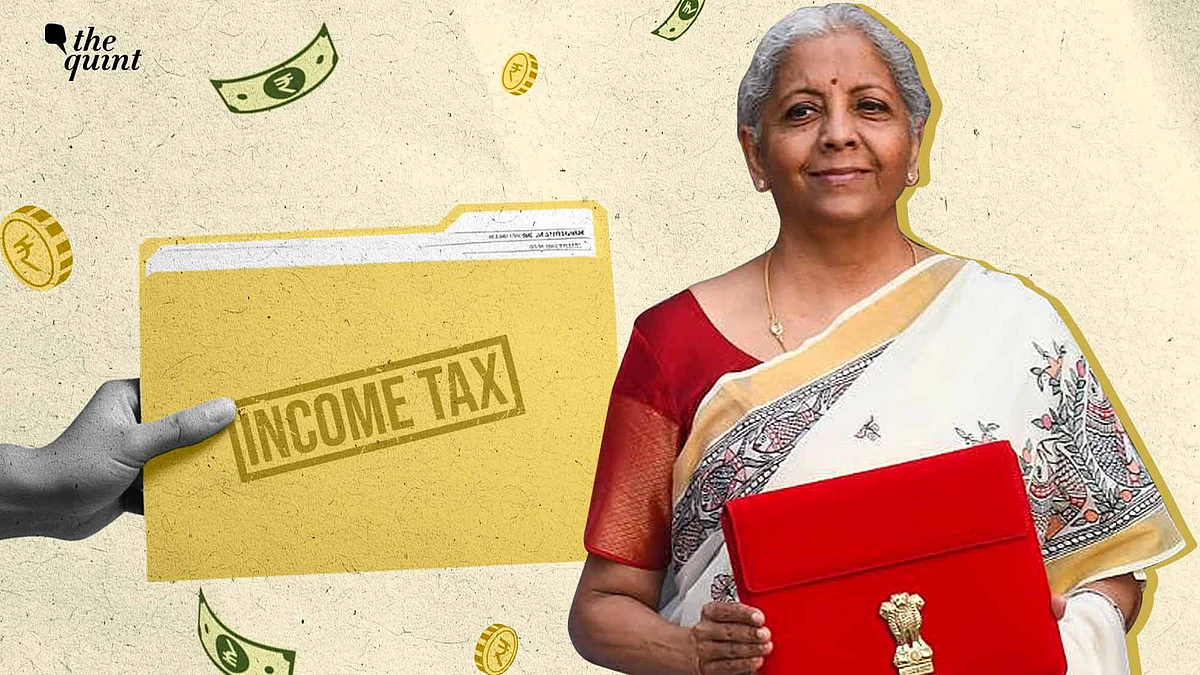
Reading Between Red Lines: Is Vote Populism Jeopardising India's Tax Growth?
India’s tax policy is becoming subservient to vote populism, writes Subhash Chandra Garg.

advertisement
The central government’s net income tax collections declined by 3.9 percent till 11 August 2025, screamed newspaper headlines. The Controller General of Accounts (CGA) reported 0.45 percent decline in direct taxes receipt in first quarter of 2025-26 (2025-26 Q1), with the month of June reporting big negative growth of 5.87 percent.
The Gross Tax Receipts (GTRs) were barely 4.6 percent up in 2025-26 Q1, against the budgeted 10.8 percent growth for 2025-26 over 2024-25 RE, that too because of a major accounting adjustment.
What is happening to India’s tax growth? Why are there so many red lines? Will India see red ink all over in 2025-26?
2024-25 Numbers: Warning Signals
The CGA’s provisional data for 2024-25 warns of impending trouble.
• The Government of India's (GoI) non-debt receipts (all receipts except borrowings) at Rs 30.78 trillion turned out to be only 97.8 percent of 2024-25 RE (Rs 31.47 trillion).
• GoI’s net tax receipts (Rs 24.99 trillion) were weaker at 97.7 percent of RE. Capital receipts, including disinvestment (Rs 0.42 trillion) had the weakest outing at 70.9 percent of RE. Only non-tax receipts (Rs 5.38 trillion) at 101.2 percent of RE saved some blushes.
A 2.3 percent shortfall in tax receipts, estimated only two months back on 1 February while presenting Budget 2025-26, should be causing some anxiety to the government.
Total expenditures (Rs 46.56 trillion) were also lower (98.7 percent) than the budgeted amount, leading to savings of Rs 60,970 crore. As savings were marginally lower than reduction in non-debt receipts (Rs 68,713 crore), fiscal deficit went up marginally from Rs 15.70 trillion (2024-25RE) to Rs 15.77 trillion in provisional estimates (PE).
The Goods and Services Tax (GST) receipts (central GST, integrated GST and GST compensation cess) at Rs 10.26 trillion against RE (Rs 10.62 trillion) had a shortfall of Rs 35,408 crore (3.33 percent). Growth in GST receipts for 2024-25 over 2023-24 (Rs 9.57 trillion) was also a tepid 6.41 percent.
GoI had projected PIT receipts for 2024-25RE at Rs. 12.57 trillion. As per provisional estimates, PIT receipts at Rs. 12.35 trillion turned out to be 98.23 percent of the RE. PIT receipts recorded growth of only 6.65 percent in 20024-25Q2 and 6.08 percent in 2024-25Q4.
Warning clouds were certainly gathering.
Towing the Red Line
The first quarter numbers raised real alarm. The 2025-26 Q1 has witnessed erratic performance in the case of indirect taxes.
The GST receipts (Rs 2.97 trillion) were 16.19 percent higher than receipts (Rs 2.56 trillion) in 2024-25 Q1. This was, however, on account of non-distribution of IGST receipts of Rs 27,312 crore whereas the government had distributed much higher (-10,176 crore) IGST in 2024-25 Q1.
Excise duties (Rs 55,605 crore) recorded growth of 8.27 percent, whereas customs duty (Rs 42,414 crore) were down by 9.88 percent. Excluding impact of IGST gymnastics, receipts of four indirect taxes (CGST, Compensation Cess, Customs, and Excise) at Rs 3.68 trillion in 2025-26 Q1 was barely 0.97 percent higher than receipts of Rs 3.65 trillion in 2024-25 Q1.
No Confidence-building Performance
Red lines became clearly visible in case of direct taxes. Corporation tax receipts at Rs 1.73 trillion in 2025-26 Q1 were 1.16 percent lower than receipts of Rs 1.75 trillion in 2024-25 Q1.
The consequences of slowing economy and the largess of exempting incomes up to Rs 12 lakh from income tax had started showing up. In June 2025, the PIT growth was (-)12.17 percent. Securities transaction tax (STT), part of direct taxes, recorded a decent growth of 12.14 percent in Q1 (Rs 13,015 crore against Rs 11,606 crore in 2024-25 Q1) yet could not prevent overall direct taxes from plunging into negative growth of 0.45 percent.)
The government should have seen impending fiscal disaster from the first quarter tax performance.
Red Ink Getting Darker
Data released by Central Board of Direct Taxes (CBDT) on 12 August are disquieting. Gross direct tax (GTR) collections in 2025-26 (up to 11 August) at Rs 7.99 trillion contracted by 1.9 percent on gross basis (Rs 8.14 trillion in 2024-25 corresponding period), whereas on net basis (gross minus refunds, which is actual government income) at Rs 6.4 trillion contracted by as much as 3.9 percent compared to net receipts of Rs 6.91 trillion in 2024-25 (same period).
It confirmed that the negative fiscal effect of largess granted in Budget 2025-26 (no tax up to Rs 12 lakh income and lower tax slabs upto income of Rs 25 lakhs) would be more severe than Rs. 1 trillion loss touted by the Finance Minister, Nirmala Sitharaman.
While the exact contours of ‘reforms’ and ‘Diwali gifts’ are yet to be approved by the GST council, the Centre’s deliberately ‘leaked/publicised’ proposal suggests that 12 percent slab will be merged with five percent and a large number of goods in the 28 percent slab will be brought to 18 percent.
It may be safe to assume that the GST tax giveaways will cost between Rs 2 to 2.5 lakh crore to centre and states put together.
Tax receipts will go for a toss. Direct tax receipts are reeling under the impact of gift granted before the Delhi elections. GST receipts will be a casualty of Diwali gift promised before the Bihar elections. India’s tax policy is becoming subservient to vote populism. The red ink is bound to spill all over.
(Subhash Chandra Garg is the Chief Policy Advisor, SUBHANJALI, and Former Finance and Economic Affairs Secretary, Government of India. He's the author of many books, including 'The $10 Trillion Dream Dented, 'We Also Make Policy', and 'Explanation and Commentary on Budget 2025-26'. This is an opinion piece, and the views expressed above are the author’s own. The Quint neither endorses nor is responsible for the same.)
- Access to all paywalled content on site
- Ad-free experience across The Quint
- Early previews of our Special Projects
Published: undefined